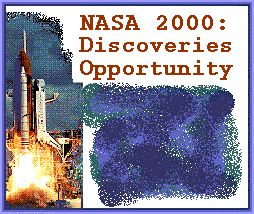 |
NASA 2000:
New Frontier of Possibilities and Opportunities with Historic Cooperation in Space Odyssey |
| International Space Station. Expedition One crew. Liquid water on Mars. Shuttle Radar Topography mapping. SOHO sees turbulent Sun. NEAR at asteroid Eros. TRACE solar mystery. Largest-ever ozone hole. Two decades of Mars exploration. | |
|---|---|
